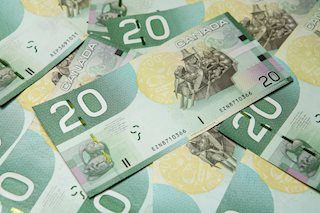USD/CAD rises toward 1.3800 ahead of US Retail Sales data
|
- USD/CAD appreciates due to the fading likelihood of further bumper rate cuts by the Fed.
- CME FedWatch Tool indicates a 92.1% probability of a 25-basis-point rate cut in November, with no anticipation of a 50-basis-point reduction.
- The Canadian Dollar faces challenges as September’s inflation data have reignited expectations for a 50-basis-point rate cut by the BoC.
USD/CAD gains ground due to solid US Dollar (USD), which could be attributed to the fading likelihood of further bumper rate cuts by the Federal Reserve (Fed) following strong US labor and inflation data. The USD/CAD pair trades around 1.3770 during the early European hours on Thursday.
Market expectations are leaning toward a total of 125 basis points (bps) in rate cuts by the US Federal Reserve (Fed) over the next year. According to the CME FedWatch Tool, there is a 92.1% chance of a 25-basis-point rate cut in November, with no expectation of a larger 50-basis-point reduction.
Traders await the US Retail Sales data, scheduled to be released later in the day. Expectations are for monthly consumer spending to increase by 0.3% in September, up from 0.1% in the previous reading.
The Canadian Dollar (CAD) is under pressure as Canada's latest inflation report for September has reignited expectations for a 50 basis point rate cut by the Bank of Canada (BoC) next week. The annual inflation rate dropped to 1.6% in September, the lowest since February 2021, falling below the central bank's 2% target.
Additionally, Standard Chartered's Research report anticipates that the BoC will implement a 50 basis point rate cut, rather than the previously expected 25 bps, at both of its remaining meetings in 2024. Slowing economic growth, declining inflation, rising inflation expectations, and swelling mortgage costs are contributing to the case for deeper cuts. The forecast now sees the BoC's policy rate at 3.25% by the end of 2024 and 2.25% by the end of 2025, down from prior estimates of 3.75% and 3.0%, respectively.
Canadian Dollar FAQs
The key factors driving the Canadian Dollar (CAD) are the level of interest rates set by the Bank of Canada (BoC), the price of Oil, Canada’s largest export, the health of its economy, inflation and the Trade Balance, which is the difference between the value of Canada’s exports versus its imports. Other factors include market sentiment – whether investors are taking on more risky assets (risk-on) or seeking safe-havens (risk-off) – with risk-on being CAD-positive. As its largest trading partner, the health of the US economy is also a key factor influencing the Canadian Dollar.
The Bank of Canada (BoC) has a significant influence on the Canadian Dollar by setting the level of interest rates that banks can lend to one another. This influences the level of interest rates for everyone. The main goal of the BoC is to maintain inflation at 1-3% by adjusting interest rates up or down. Relatively higher interest rates tend to be positive for the CAD. The Bank of Canada can also use quantitative easing and tightening to influence credit conditions, with the former CAD-negative and the latter CAD-positive.
The price of Oil is a key factor impacting the value of the Canadian Dollar. Petroleum is Canada’s biggest export, so Oil price tends to have an immediate impact on the CAD value. Generally, if Oil price rises CAD also goes up, as aggregate demand for the currency increases. The opposite is the case if the price of Oil falls. Higher Oil prices also tend to result in a greater likelihood of a positive Trade Balance, which is also supportive of the CAD.
While inflation had always traditionally been thought of as a negative factor for a currency since it lowers the value of money, the opposite has actually been the case in modern times with the relaxation of cross-border capital controls. Higher inflation tends to lead central banks to put up interest rates which attracts more capital inflows from global investors seeking a lucrative place to keep their money. This increases demand for the local currency, which in Canada’s case is the Canadian Dollar.
Macroeconomic data releases gauge the health of the economy and can have an impact on the Canadian Dollar. Indicators such as GDP, Manufacturing and Services PMIs, employment, and consumer sentiment surveys can all influence the direction of the CAD. A strong economy is good for the Canadian Dollar. Not only does it attract more foreign investment but it may encourage the Bank of Canada to put up interest rates, leading to a stronger currency. If economic data is weak, however, the CAD is likely to fall.
Information on these pages contains forward-looking statements that involve risks and uncertainties. Markets and instruments profiled on this page are for informational purposes only and should not in any way come across as a recommendation to buy or sell in these assets. You should do your own thorough research before making any investment decisions. FXStreet does not in any way guarantee that this information is free from mistakes, errors, or material misstatements. It also does not guarantee that this information is of a timely nature. Investing in Open Markets involves a great deal of risk, including the loss of all or a portion of your investment, as well as emotional distress. All risks, losses and costs associated with investing, including total loss of principal, are your responsibility. The views and opinions expressed in this article are those of the authors and do not necessarily reflect the official policy or position of FXStreet nor its advertisers.